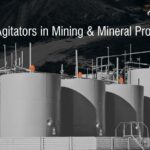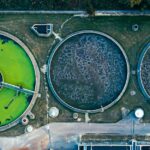
Conditioning & Mixing Tank Agitators – Mining & Mineral Processing
In the dynamic realm of mining and mineral processing, the

Biogas production operations with biogas mixers is rapidly becoming an integral component of the developing renewable energy landscape. It takes biomass from practically any source and breaks it down using bacteria. This creates a mixture of primarily methane and carbon dioxide that can suit natural gas applications and infrastructure when refined. Waste from wastewater treatment, agriculture, forestry, and other industries can be safely and responsibly disposed of while generating additional power.
Individual operations can vary widely in their design. The waste slurries they handle range from as little as 1% solids to as high as 80%. Most will find themselves dealing with a slurry of around 30% solids. In any case, agitation is an essential component of multiple process steps. Agitators serve to prevent solids settling, ensure homogeneity, and maintain optimal conditions for biogas production. Dynamix designs effective agitation solutions to meet the unique challenges posed throughout the process.
There is a need for effective agitation from the very beginning of biogas production. Plants will receive substrate either as a slurry or must slurrify solid feedstocks. In the case of incoming slurries, the receiving tanks will include agitators for homogenization before pumping to the next step.
Operations must blend solid feedstocks or thick slurries with recycled process liquids in order to achieve the required consistency. This blending is essential to ensure that the subsequent process step receives a homogenous feed. Vigorous, high shear agitation is appropriate at this step to allow for rapid blending, reducing retention time and mixing tank size.
The central process of most biogas production operations is anaerobic digestion. Complex organic molecules like carbohydrates, proteins, and fats are broken down into various organic acids, which are then broken down into methane and carbon dioxide. The bacteria that carry out these steps require specific pH and temperature conditions and mixing to promote interactions with the organic substrate.
This process is often carried out in two or more sequential tanks to allow different types of bacteria to work at optimal pH levels. The first is the hydrolysis tank which runs at a low pH. Here, mixing is required to ensure that incoming slurry is quickly dispersed and homogenized. Stratification is another major concern, with both floating layers and solids settling possible. Low-speed mixing with large-diameter impellers can provide adequate mixing to prevent these issues without excessive energy requirements.
The second tank is where biogas production takes place, often called the fermenter or anaerobic digester. This step has a significantly higher retention time than hydrolysis, making energy efficiency one of the most pressing demands for agitators. While there is a need to have a quick enough turnover to mix the incoming low-pH feed into the more neutral digester, the primary concern is maintaining the overall physical and thermal homogeneity.
Agitators for biogas production need careful engineering to ensure that they can meet process requirements. That goes for the challenges found during each step of production, along with the unique requirements of individual operations. At Dynamix, our team engineers custom biogas mixers and agitators to provide optimal performance. You can contact us today to see how we can help your operation.

In the dynamic realm of mining and mineral processing, the

Mining operations are essential for meeting the world’s resource needs, yet they

Water treatment is a complex yet vital process that ensures
Subscribe to our newsletter for helpful technical publications and industry announcements.

This website uses cookies to ensure you get the best experience on our website